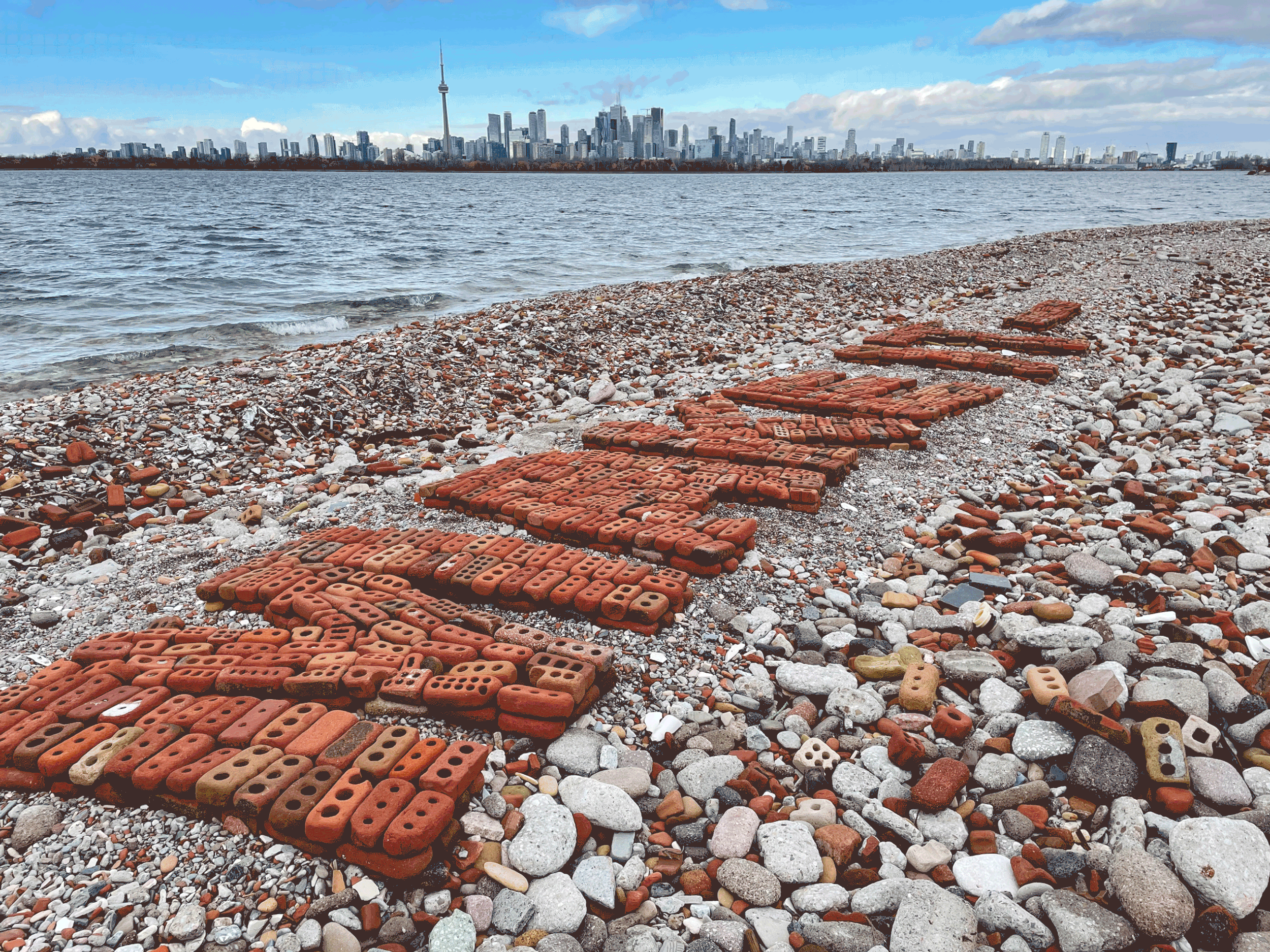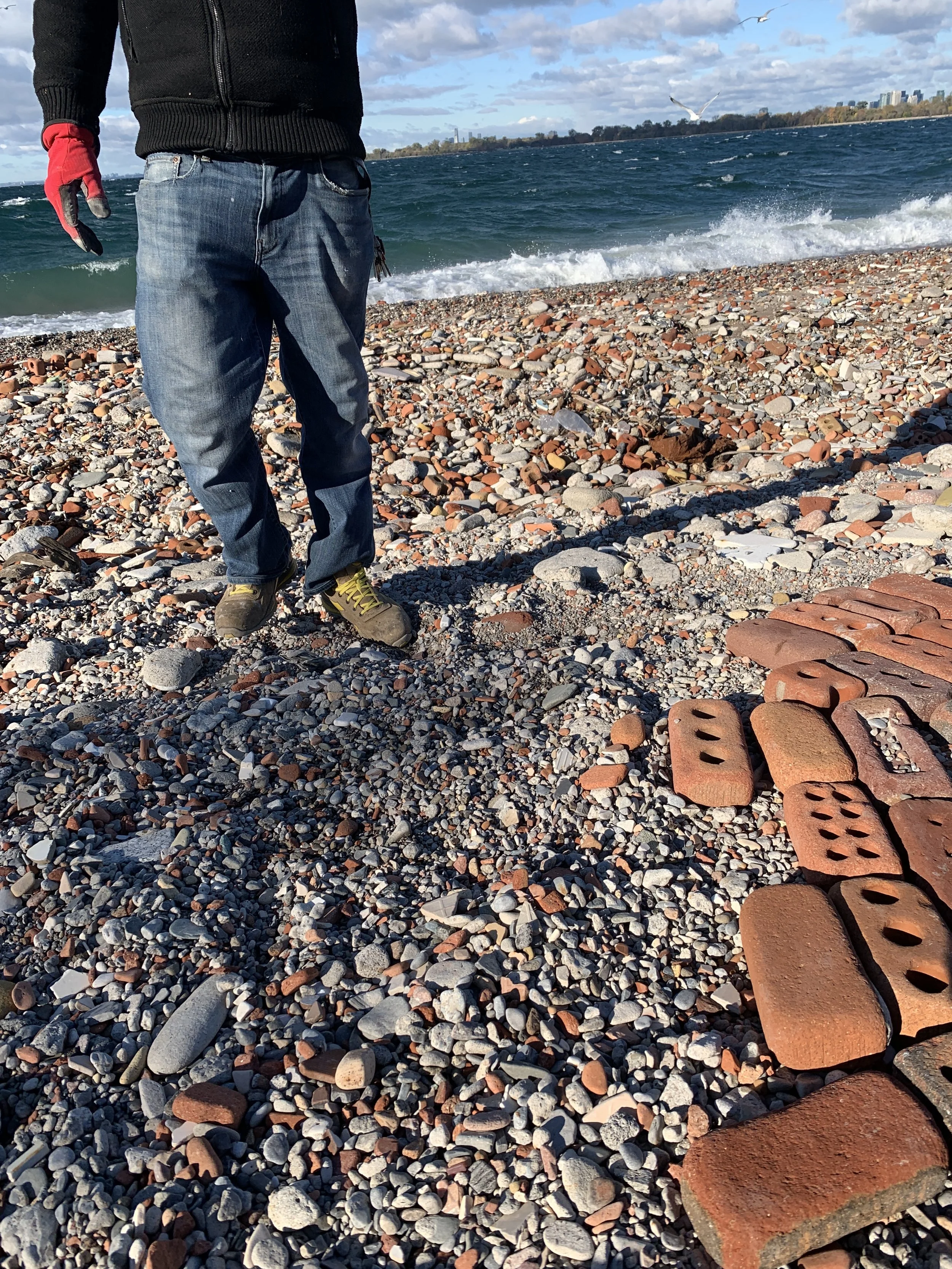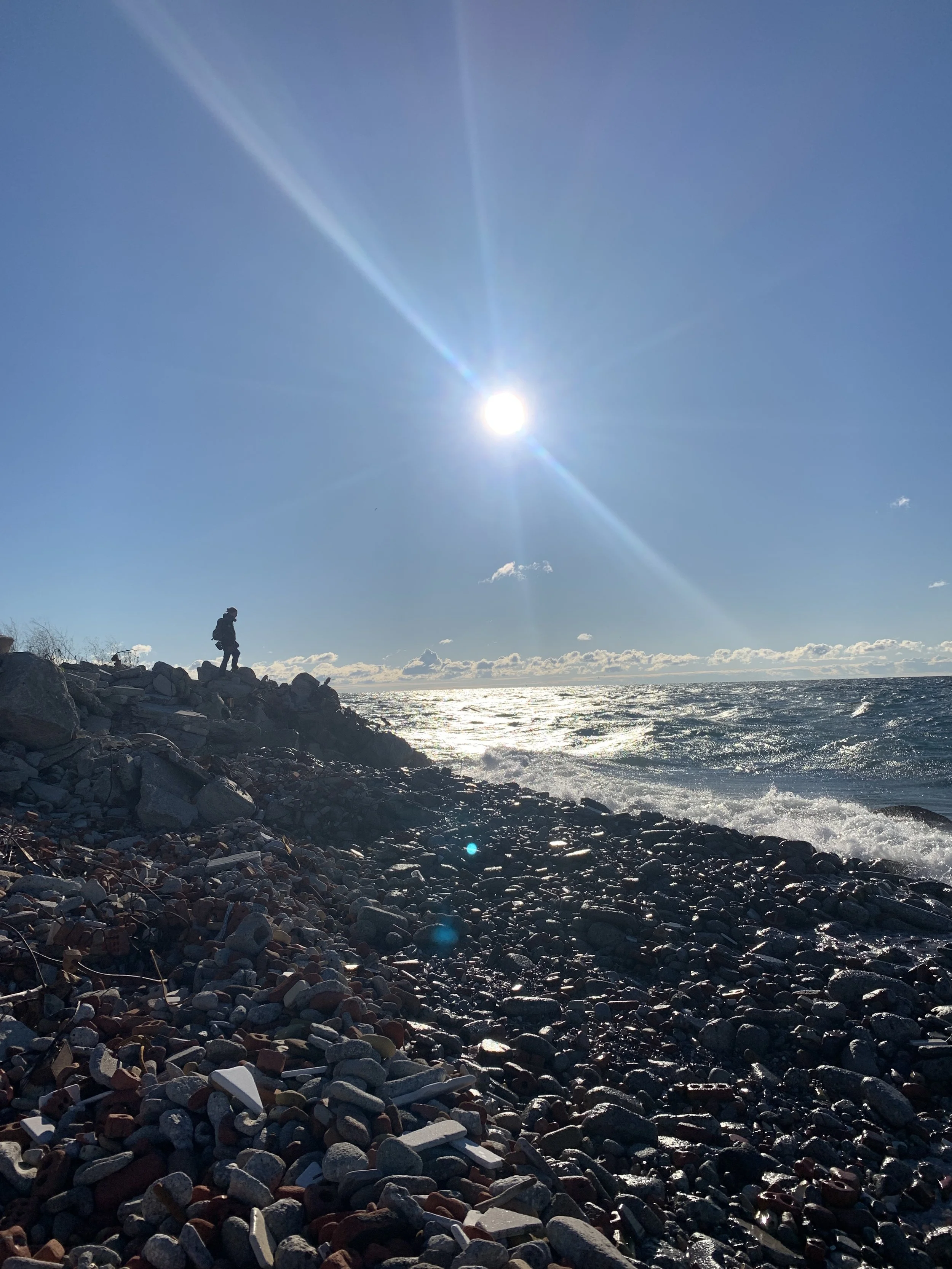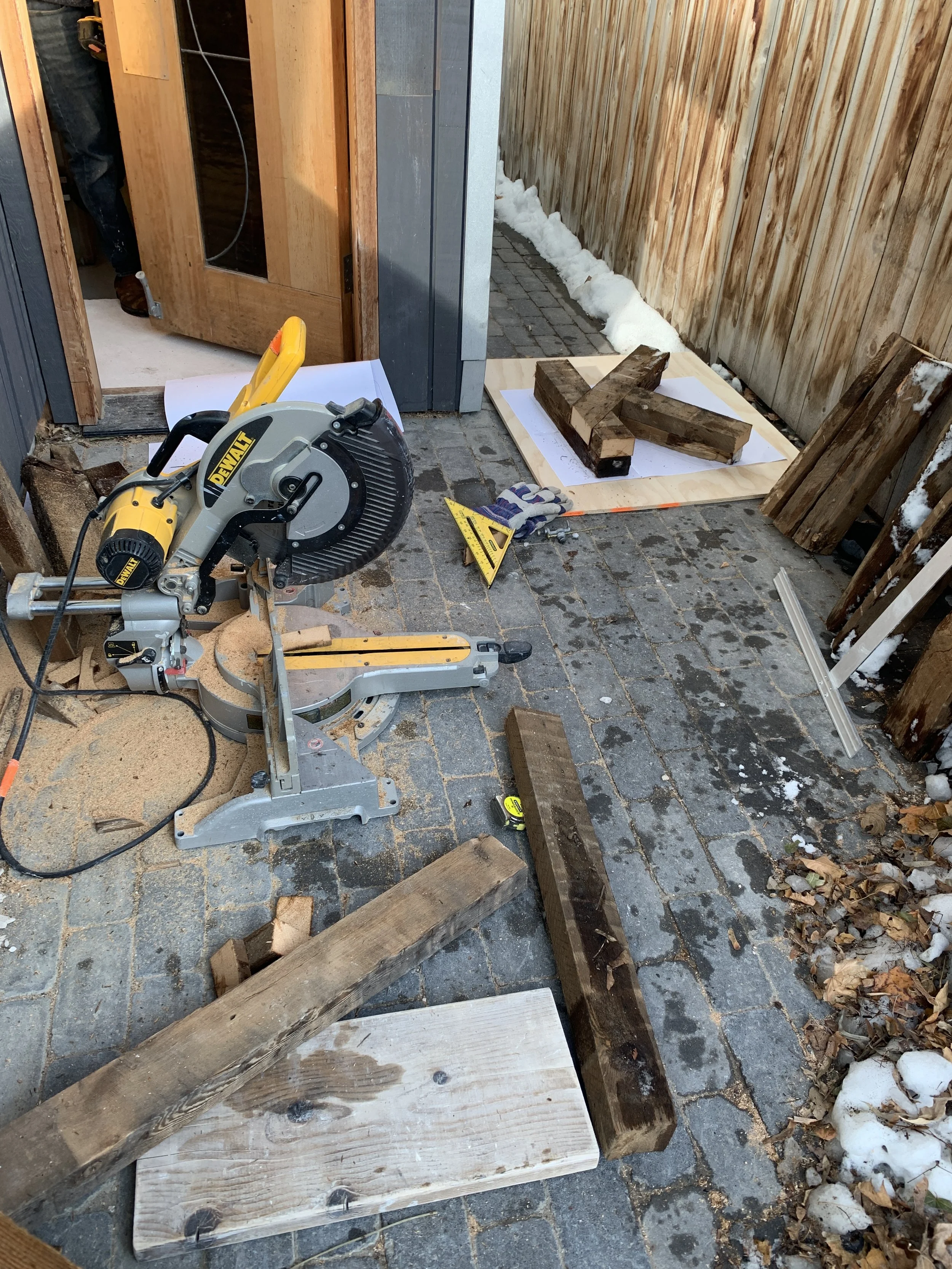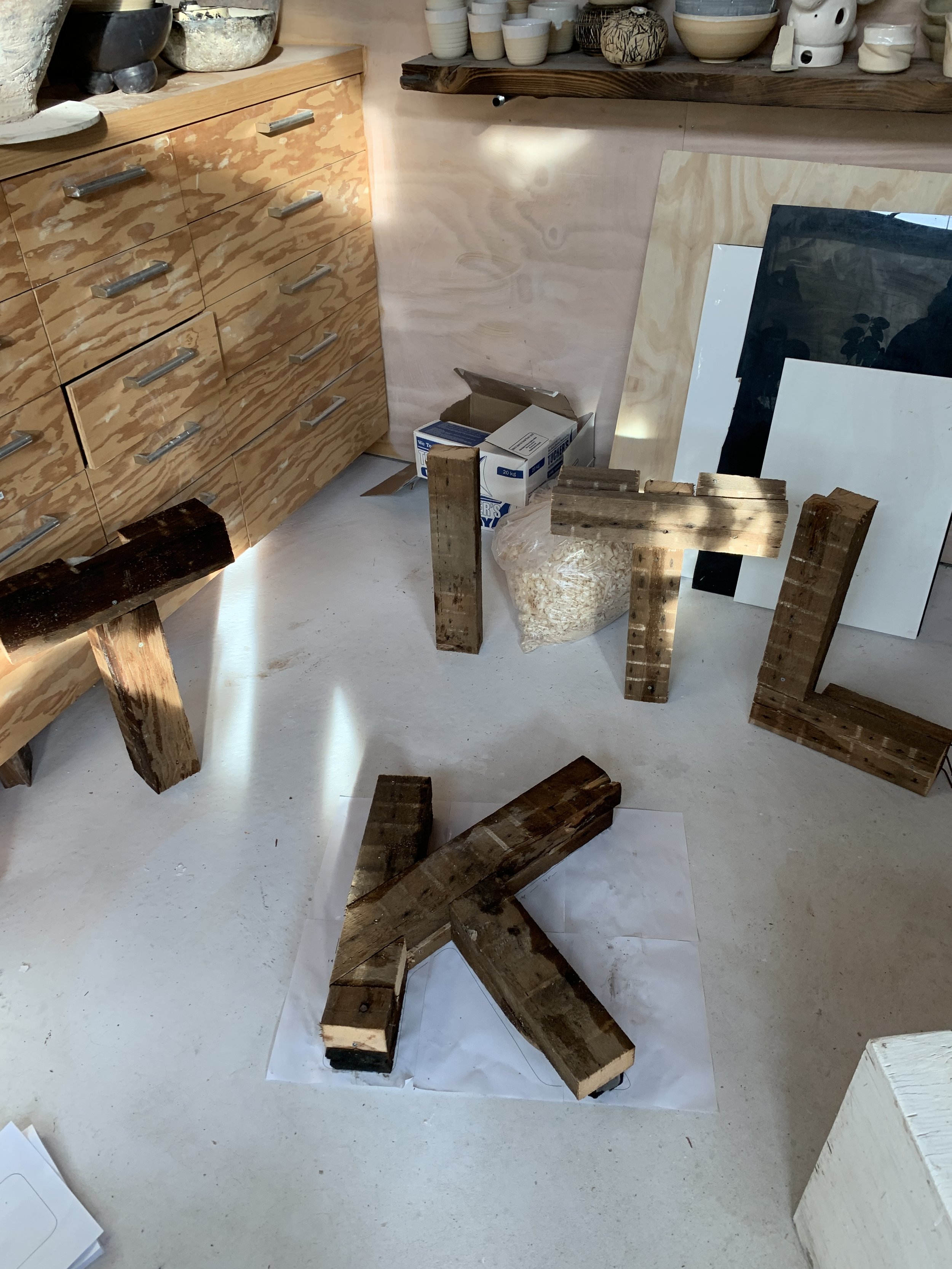Thomas Bollmann + tahsine al hassane
MAKE IT LAST - we built knowing the outcome, and we built all the same.
Artist Statement
MAKE IT LAST — is a series of documented time and site-specific installations using found, and at times reclaimed, material from toronto conceptualized and built by tahsine al hassane and thomas bollmann in the fall and winter of 2021-22. the words “make it last” are posed as a question, a statement, a request. this collaborative project challenges our perceptions and stance on preservation, impermanence, discernment, essentialism, rehabilitation, flexibility and the “natural order of things”, with consideration given to environmental impact and human interventions. musings on societal structures and habits at large – throw-away culture, consumption, capitalism, ghosting, control, as well as tenderness, care, connection and understanding presented themselves in the project. what are we making last, knowing nothing will (in its existing form?) should we put energy and effort into tending and caring even when we know it cannot be perpetually sustained? why? the wisdom gained, iterations and evolutions that are the result of the process and experience of in the moment making is akin to our lives. we live, we do (and do, and do, and do,) we die. we…?
will you tend to a thing
will you even care
can you make it last
is it worth your fare
does it even matter
can it just be
transform how it will
let us, let us see
will you tend to a thing
or choke hold, control
do you consider the outcome
how does it unfold
does it even matter
is it out of our hands
still hands do the toiling elemental lands
will you tend to a thing
when it may not be good
trust in evolution
perhaps it could
does it even matter
what does really
the waves will keep on rolling
in seeming perpetuity
will you tend to a thing
will you even care
can you make it last
is it worth the dare
does it even matter
can it just be
transform how it will
let it, set it free
In Conversation.
Debrief Interview with Dara Vandor
Thomas and Tahsine were interviewed after the project’s completion and the final submission of their work. The interview has been condensed for length and clarity.
RULES OF PLAY:
Six artists of varying experience and background, working across diverse media, were blind paired into three teams of two. Their brief was to take either eight days each–or sixteen days per team–to collaborate, conceptualize and create work based on a theme dictated by the DEALR. The materials and time they invested were supported by the project. Their project’s progress was charted and aided along the way by the DEALR, via Zoom. What they came up with? Call it chance, call it luck, or call it art.
DARA: Tell me about the finished projects and what they signify.
TAHSINE: The project evolved over time. We started talking and slowly things started clicking. We wanted to do something that was not in our studios, we wanted to be outside, we wanted to do something that had public engagement, and we wanted to do something that was an installation. We didn't know where it was going, so we just started with the location, Tommy Thompson Park, which had meaning to both of us. We started to do site visits, thinking about what it was that we wanted to say. We landed on text-based work, which is an extension of my practice, combined with building, which is an extension of Thomas's practice. We landed on the words “make it last,” even though we knew that the project wouldn't. The project iterated over time, and was an ongoing experiment. As we worked on it, we thought about what it signified, how we could make it better, and how we could tend to the project and to each other.
THOMAS: It was an experiment to see what happened with the first iteration of the project and how we put it out into the world. We took the lessons from that to then push it onto the next iteration. You begin with big ideas, but when you start, you get a better sense of how big the project actually becomes. The outcomes are so different every single time. I really liked that the installation morphed into this funny word, and that is what people came up with in this place in that situation.
DARA: What amazes me is the amount of work it took to change “make it last” to “ass.” They were actively hauling bricks in pursuit of a punchline.
TAHSINE: Not as much work as Thomas lugging all those bricks. It was very intensive. It wasn’t an easy thing to make—though that commitment was at the root of the project. I remember being on the beach, wanting to make it last forever, to add trees or a garden. Thomas had to point out that all of our work was going to wash away with the water after a week or two. We had different perspectives coming into the project. Mine shifted—I think I came in with a little bit of naiveté, a little bit more of a romantic side, thinking, we can make it last. It was a little grandiose. Thomas is more serious and realistic about his approach to things. He knew exactly what was going to happen to this thing. Though deep down, I knew what was going to happen, nothing lasts, right? It was interesting how someone played with that word, and decided to make a mockery of us. Sometimes it takes me 50 times to learn a lesson.
THOMAS: It took us almost four days to build. We intended to get a drone and shoot the words from above. Then the first winter storm of the year hit right after we finished. When I came back two days after, I saw the word “ass”—before we were even done! So that final shot doesn’t even exist. But it actually makes total sense. It doesn't matter how many hundreds of bricks you use—if it's not winter, or a storm, it's people who will change something.
TAHSINE: Despite your hopes for how a project will turn out, you really have to just let it go. You just don't have control. It’s a lesson.
DARA: The medium and the message were very aligned. Is any of it still there?
THOMAS: I don't know. I haven't been back because the path isn’t cleared in the winter. But part of it got washed away almost immediately. We chose the spot because it was quiet, mostly used by birdwatchers.
DARA: Why Tommy Thompson Park? You said it meant something to both of you.
TAHSINE: I've always wanted to build something at that park, which I came to know about because of association. But at the end of the day, it had to do with heartbreak as a result of that association. It was really poetic for me.
THOMAS: Growing up, we couldn't really travel anywhere, so we would always go to the same beach every single damn summer. We would look for stuff on the beach, collecting fossils and hanging out. Shortly after the Berlin Wall came down, people began throwing out all their stuff because all these nice, shiny Western things became available. Friends and I would be able to pick up all these great things, things of value that were well made and would last for many more years. I remember the first time going to Tommy Thompson Park and walking on that beach, and feeling those same things. There is so much material. It's a treasure. I wonder if we might be the last generation to be able to go on a beach like that. It was also nice during COVID times to just take your bike and ride down that beach, to actually work outside.
TAHSINE: It’s really beautiful and healing. The brick on the beach represents this lost Toronto, a Toronto overtaken by glass towers. It had a personal meaning to me and to Thomas, but there is this collective meaning, built on a place that was built off of something that didn’t last. We were working with those materials that were destroyed in order to create something else of beauty, something to ignite thought.
DARA: Could you describe your style–both aesthetic and the way that you work–and then describe your partner's?
THOMAS: I would describe my style as somewhat pulled back. I don't like to make work that is too plastic or too generic. I want to keep it as simple and natural as possible, to not add anything that wouldn't be there already. Whether that is photography or ceramics, I would rather reduce than add.
As for Tahsine, she’s always found a way of catching your eye. You can't just walk by and not look at her work, or read the text. That’s the tricky part these days, to make something that people will spend even a few seconds looking at. Like me, I think that she keeps her work relatively simple.
TAHSINE: Thomas can literally do it all, and he does it all really well. His style is simple, using natural materials in a way that is very elevated, considered, beautiful, and timeless. He's a material explorer, working with all sorts of mediums. He just has that ability to create and make and do with all of this energy. Our styles and output are different, but there are so many interesting points of convergence.
As for my work, I would say that it is graphic, meaningful, considered, thoughtful, simplified, and minimal.
DARA: Tell me about the process of making these works and about collaborating with another artist.
THOMAS: After a project like this, you feel this relief at first—you've made it to the finish point. But then there is also the realization that you wouldn't have done this work by yourself. I look forward to collaborations and have done many of them now. When you work together, things will change but never into something bad. Projects always become elevated from where they started. That is the most important thing about collaboration.
TAHSINE: Sometimes there is hesitation, often we work very insularly, very solo. You wonder if you will bring anything to the table. Tensions rise and fall. It was a long project, we started in September and now it is March. The project shifted a lot. Doubts come in, and you hope your input will be heard, valued and understood. Especially as someone who doesn't always work with people on a regular basis, those doubts come in. We also had to make sure we tended not only to the project but to each other. I care about Thomas. That's why care comes up a lot in in the statement and in the ethos of the project. I haven't collaborated a lot with people, but I have now realised that I have the ability and value to add. It was actually a really nice experience.
DARA: Tell me about some of the challenges.
TAHSINE: You plan, and then all these other things come up. I ran out of physical ability on the last leg of the project, when we were actually building. I worried that I wasn’t pulling my weight. But because it was a collaboration, we stepped in as needed. I think we came through okay. Not unscathed, but pretty okay. Let's be honest, Thomas was annoyed with me. I was annoyed with him at times.
THOMAS: It would be odd if it didn’t happen. I think you would probably lose some of the quality of a project like this.
TAHSINE: We had to be honest with each other. And truth hurts. But are we still willing to push the needle? Are we still willing to stick it out?
THOMAS: I think artists in general have a hard time being critical of one another. But at the end of the day, we put out our work not for praise or to hear how much someone loved it. I want to know what people don't like as well. Because it's all just another step towards something else.
TAHSINE: There is a reciprocal desire to level each other up, because we both want something good at the end of the day. Sometimes you do have to push for your ask, and try to be heard. It was an exercise for people who don't always communicate so clearly. We’ve been in each other’s orbit for a few years. If I were working with a random person in this collab project, maybe I wouldn't have spoken up as much.
THOMAS: Yes, we knew each other before this but sometimes it takes months before you can say these things. I am now quicker to voice my thoughts with fellow ceramicists.
TAHSINE: This was my first big collaboration and it was an affirming experience. Prior to this project, I might not have felt as confident as I do now. I felt I could be myself and not offend or hurt someone’s feelings. That will carry on into the next collaboration.
DARA: Let’s return to your installations. One of them is resurrected and supported over days, weeks, months—while the other one is co-opted, made into a bit of a punchline. Same action, different reaction. How does that make you feel?
TAHSINE: I really wanted more engagement at Tommy Thompson. Considering the placement of it, what it would take to get there, and the season we built in, it just wasn't populated. The forest site had more people walking through it, it's close to a school and houses. People are already feeling a very strong connection to it. The words we chose connected to something that they already believe in. I kept thinking about if we had only directed more people to Tommy Thompson. I wasn't telling a lot of my friends, because we were just kind of building the project. At that point, we didn't really know what it was, or what it would turn out to be. As it started taking shape, I wanted more people, even just to help Thomas build. If we did a call, maybe people would have tended to it. If more people had known about it, maybe there wouldn't have been that interaction where somebody made the word “ass” out of it.
THOMAS: It speaks volumes to who's going to that beach, right? I mean, I thought it was a bunch of birders, who are extremely protective over their spot. But I know that it was not a birder who was moving around the letters, it was some hipster getting stoned on the beach. But it's not worth less, it's just different. I'm happy that both things worked out that way. It is okay that they didn't last that long, I actually have no issue with that at all.
The old growth wood in the ravine is slated to be chopped down to extend the GO Train line. The neighbourhood is outraged. The timing of our project meant something to people. In the first week of our project being there, a child put a little poster on it that said “protect the trees.” They made the project their own and made it into more than what it was prior.
In this installation, we used reclaimed wood that I gathered from a house next door. We didn't put new materials in—we just wanted to see what would happen. The last picture in the video was actually just taken three days ago. The installation is still there. It must have fallen down maybe 20 or 30 times. But people came back over and over again to put it back up. In that way, it was super successful, but not any more than the installation on the beach.
DARA: what does the “it” in “make it last” signify for you?
TAHSINE: I think the point is to receive “it” from wherever you are. When we talked about the project, it ran the gamut from personal things like heartbreak to a warm feeling. Summertime. Relationships. Heartbreak. What are we trying to make last? On a macro level, “it” can be a system: why do we make certain systems last? Why do we uphold certain things and not tear down others? The “it” is up for consideration, and can be a lot of different things.
THOMAS: I think that there is a need to abandon the idea of buying things and then throwing them away. For way too long, we have been going about this wrong, thinking that everything has to be new and fancy and glossy. But we already have everything, we just need to use it differently, to use what we have to make something that is new and interesting. The entire project would be “it.”
TAHSINE: This resourcefulness is key to both our practices. Making something beautiful out of something some people might think is not beautiful.
DARA: On top of the challenges inherent in a project like this, you had to deal with COVID and the cycles of lockdown. What impact did the pandemic have on your work?
TAHSINE: We decided to get outside, and stay outside. Let’s get as mask-free as we can, get as much natural air as we can, even in winter.
THOMAS: Maybe under normal circumstances, we wouldn't have done it like that. But it was perfect.
DARA: What did you learn from each other?
THOMAS: Words are not part of my practice normally. I like the idea of getting something across by actually writing it out. Because we're so word-driven as a culture, the audience will read the work if they want to or not. We got you already. The project really opened up a whole new way of looking into installations, as well as using text in the other work that I do.
TAHSINE: Resilience and dedication. Thomas works so hard. He does so many things and does them very well. He’s also good company—it was really fun. I also learned to keep it light and to not take things so personally. I still react, but I found more calm.
DARA: Was the project successful?
TAHSINE: Definitely. I'm excited about this project, it was very meaningful. I loved how we iterated it. In the process of doing these installations, I had a lightbulb moment: “this is the type of artist that I am, I am an iterative artist.” I make small shifts in the things that I do. I found a better understanding about the way that I work while I was working with someone else. Maybe because they are a mirror, but it was something that I will always remember.
THOMAS: The project was done the moment I took down the cameras and looked through the footage and saw people interacting with it. Because often that is what's missing for a lot of artists. They put their stuff up but then they don’t really hear the response. I follow some Instagram accounts of a few dog people that I know from the park around here, and all of a sudden, I saw our project popping up in their feed. It was cool. People were talking about it not knowing that we actually had anything to do with it. To get a conversation started and to get anything going these days isn't simple. When I saw the first hands of someone moving the letters around, or actually taking the time to move several hundred bricks to spell the word “ass” I thought, how is that not successful?
TAHSINE: We were kind of saddened by the fact that we didn't document the bricks the way that we wanted. That we didn’t get to talk about it with friends. But that's not the point, to necessarily share it. Sometimes the point is to just process through it and do it for yourself.
It was successful from the moment we started, because it's not about the end result, it's actually about the process along the way.
